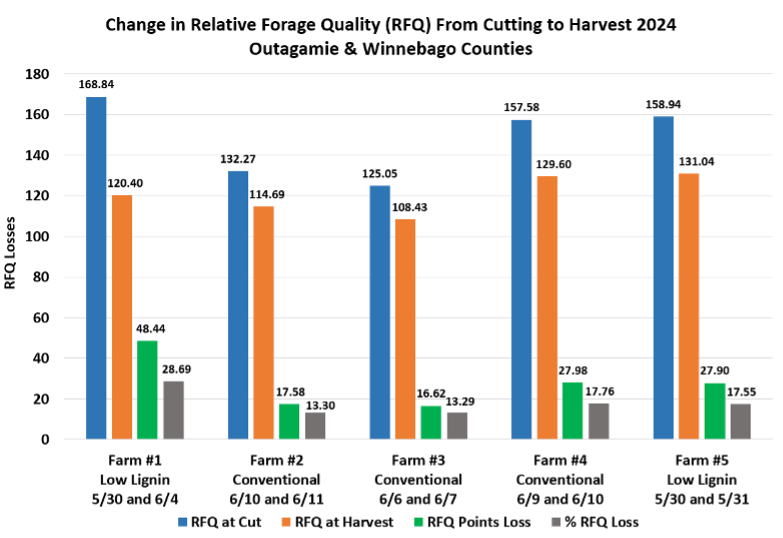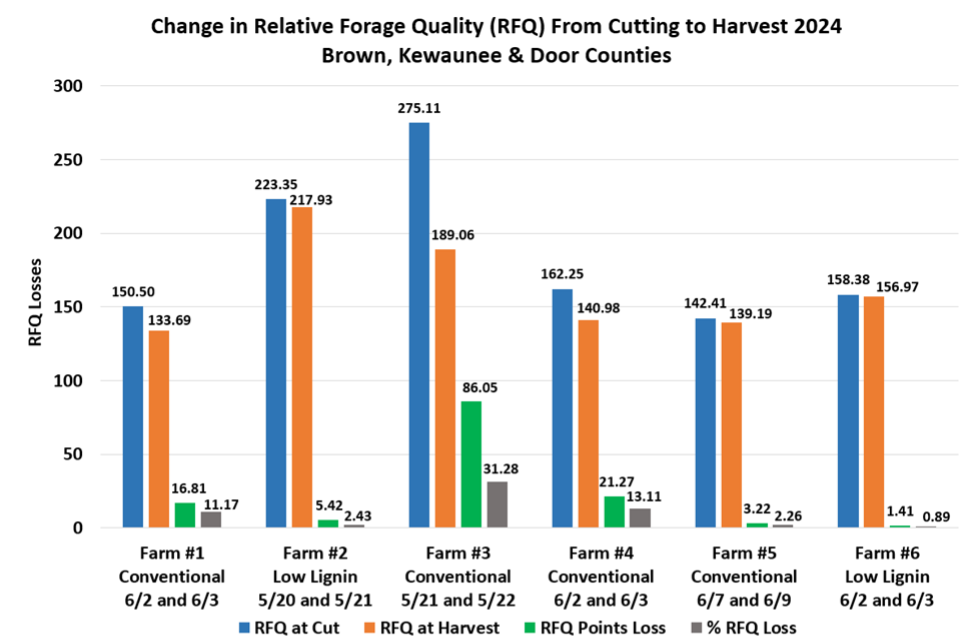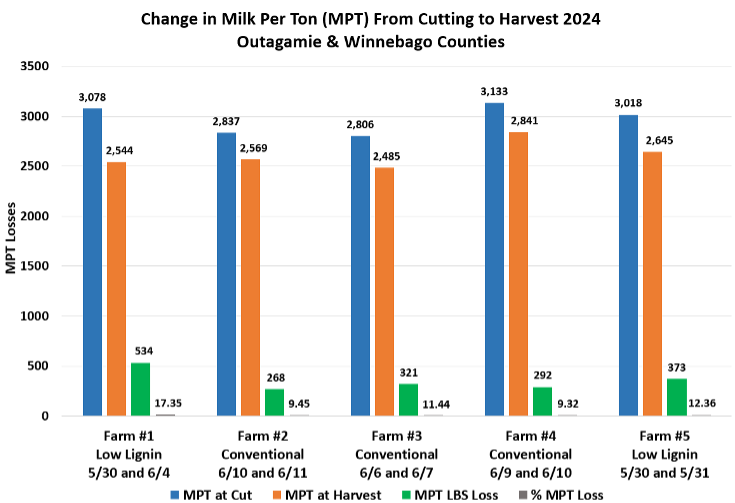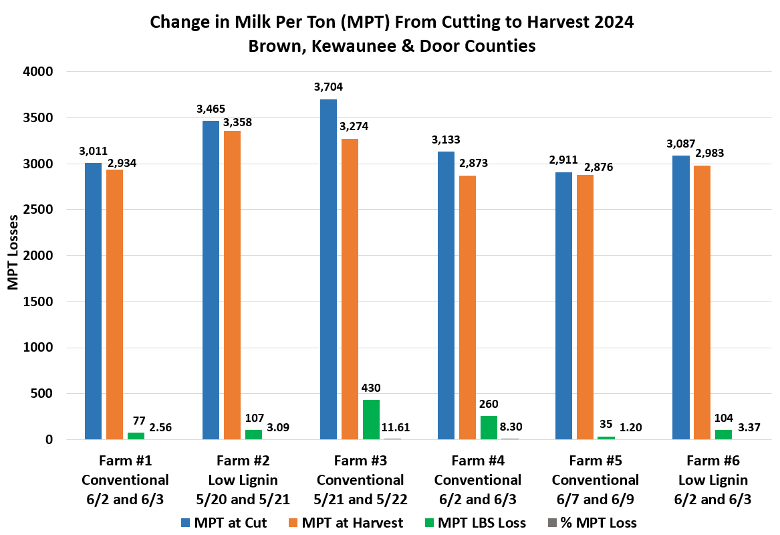Alfalfa fields in Wisconsin are showing signs of life as recent rains and a few warm spring days have jump started the season. UW–Madison Division of Extension crops educators are similarly gearing up for Alfalfa Harvest Quality measurements. First crop alfalfa represents the largest quantity (36% of total season yield in a four-cut system) of forage dry matter (DM) yield each year. Proper harvest management allows growers to optimize their alfalfa harvest calendar for the remainder of the growing season.
Thanks to partnerships with local Forage Councils, agronomists and nutritionists, the Extension team provides Predictive Equations for Alfalfa Quality (PEAQ) stick measurement reports across Wisconsin prior to first crop harvest to help growers identify optimum harvest timing for first cutting alfalfa. The 2025 effort will be funded largely from a MFRP (Midwest Forage Research Proposal) grant from the Midwest Forage Association (MFA) and Dairyland Laboratories. Extension educators will expand the project to include scissor cut samples that will be analyzed for quality each week to help us track correlations between PEAQ measurements and near infared (NIR) forage analysis results.
Efforts may begin as early as the week of May 5th in some parts of the state to assess alfalfa height and stage of maturity, with the first scissor clip measurements to commence when the crop reaches 12-15” in height. Each week, educators and local forage council members will report crop height, stage of maturity, PEAQ stick Relative Feed Value (RFV), and Relative Forage Quality (RFQ) by location.
Relevant Alfalfa Management Tools
Extension educators will share data locally via newsletters and websites, and a partnership with the University of Minnesota Extension service allows us to share cross-state data via an online tool. This is the best place to track all the alfalfa data from both states as the season progresses. You can filter your search to get results close to you or identify trends across both states. Check out the tool at go.wisc.edu/AlfalfaHarvestAlert.
Want to follow along in your fields? Here is a guide to estimating RFV in the field using PEAQ.
Looking to buy or sell alfalfa off the field? Read more about pricing standing alfalfa.
Be sure to scout for pests, with a close eye on managing alfalfa weevil and scouting for other first crop insect pests.
Take some time to plan your 2025 Alfalfa Cutting Schedule – Use the UW Alfalfa Cutting Tool. Learn more about using the tool by watching our Focus on the Alfalfa Toolbox webinar recording.
Spring is a busy time of year for growers, and these tools can help you prioritize forage quality for your farm. Timely decisions made early during the growing season can help you maximize both the quality and quantity of your alfalfa forage for the next 365 days.
Field Losses in 2024 First Cutting Alfalfa
During the 2024 PEAQ/Scissors Clip Project, area Extension educators in northeast and east-central Wisconsin worked with farmers and agricultural professionals to collect fresh alfalfa field samples immediately after the first alfalfa crop was cut. Once the alfalfa wilted to ensiling moisture and was harvested, another sample was collected.
The goal of this effort was to calculate what our actual field losses were between the moment the alfalfa hit the ground after cutting to when it had reached ensiling moisture and had been processed through the forage harvester. Those results for Relative Forage Quality (RFQ) and Milk Per Ton (MPT) are charted below.
Five farms in Outagamie and Winnebago County participated while another six farms in Brown, Kewaunee, and Door Counties collected and shared data. The graphs below illustrate the Relative Forage Quality (RFQ) Values at Cutting, Harvest, the number of points lost, and the % RFQ loss from the time of cutting to after harvest.
Outagamie and Winnebago Counties’ Change in Relative Forage Quality From Cutting to Harvest

The mean value at cutting for Outagamie and Winnebago Counties was 148.54 (168.84 high, 125.05 low). The mean RFQ value after harvest was 120.83 (131.04 high, 108.43 low). The mean RFQ points lost were 27.70 (48.44 high, 16.62 low) while the mean % RFQ loss was 18.12% (28.59 high, 13.29 low).
Brown, Door, and Kewaunee Counties’ Change in Relative Forage Quality From Cutting to Harvest

The mean RFQ value at cutting for Brown, Kewaunee, and Door Counties was 185.33 (275.11 high, 142.41 low). The mean RFQ at cutting was 162.97 (217.93 high, 133.69 low). The mean RFQ value after harvest was 162.97 (217.93 high, 133.69 low). The mean RFQ points lost was 22.36 (high 86.05, low 1.41) while the mean % RFQ loss 10.19 (31.28 high, 0.89 low).
The RFQ value changes between these eleven participating farms illustrate the high degree of variability we can experience not only from farm to farm, but between alfalfa varieties and field conditions at the time of cutting and harvest. Let’s hope that Mother Nature provides a more stable environment for the 2025 harvest.
Outagamie and Winnebago Counties’ Change in Mean Milk Per Ton From Cutting to Harvest

The mean Milk Per Ton (MPT) value at cutting for the Outagamie and Winnebago farms was 2,974 lbs. (3133 high, 2,806 low). The mean MPT after harvest was 2,617 lbs. (2841 high, 2,485 low). The mean MPT lbs. loss was 358 lbs. (534 high, 268 low) while the mean % MPT loss was 11.98% (17.35% high, 9.32 % low).
Brown, Door, and Kewaunee Counties’ Change in Mean Milk Per Ton From Cutting to Harvest

The mean MPT at cutting for Brown, Kewaunee, and Door Counties was 3,219 lbs. (3,704 high, 2,911 low). The mean MPT after harvest was 3,050 lbs. (3,358 high, 2,873). The mean MPT lbs. lost was 169 (430 lbs. high, 35 lbs. low) while the mean % MPT loss was 5.02% (11.61% high, 1.20% low). While there are various sources that cite what estimated alfalfa yield losses may be, on-farm efforts to collect data like this can give farmers and agricultural professionals a more accurate picture of the ranges we can experience.




